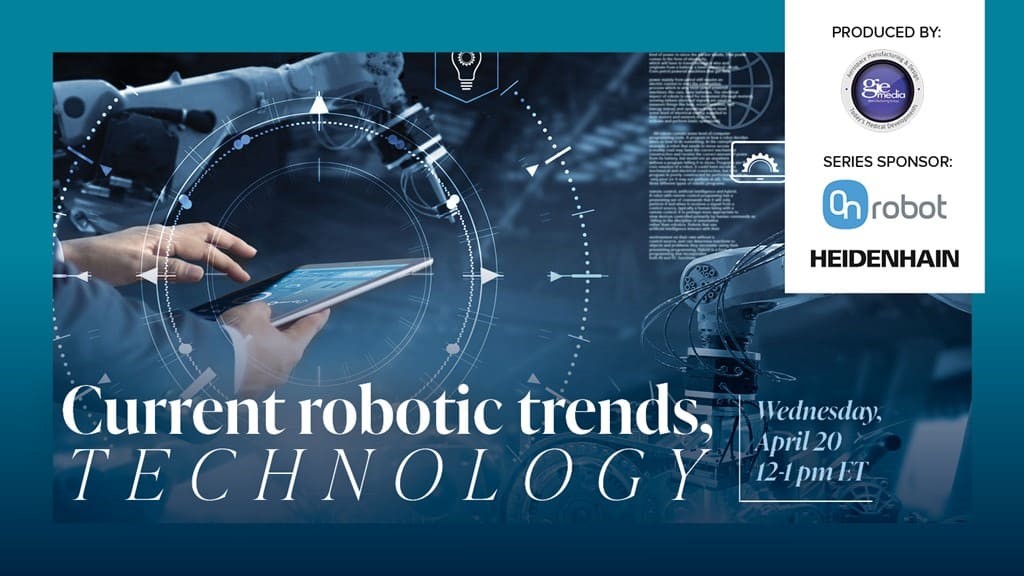With a record 3 million industrial robots operating in factories around the world – our panel of experts will discuss the latest technological advancements and trends.
In less than a month Associate Editor Jake Kauffman will be sitting down with experts from Heidenhain and OnRobot discussing the latest advancements in robotic technology.
Taking place Wednesday, April 20 at 12PM ET, topics covered will range from the latest advancements in robotics, end of arm tooling, and systems integration, to the benefits artificial intelligence (AI), the Industrial Internet of Things (IIoT), and Industry 4.0.
Click here to learn more and register today. Can’t participate during the live event? No problem. Each registered attendee will also receive a link to the recording. This content will be sent within 5 business days after the event.
Our March 31 roundtable discusses diversity, equity, and inclusion in manufacturing.
In honor of Women’s History Month, join Elizabeth Engler Modic as she moderates a roundtable discussion with leading women involved in manufacturing. Taking place Thursday, March 31 from 12 – 1 pm ET, Women to Watch in Manufacturing is your opportunity to learn the latest thoughts from women in manufacturing.
Per the U.S. Department of Commerce, although women represent about 47% of the total workforce, they only make up about 30% of the 15.8 million people employed in manufacturing industries. Furthermore, only 1 in 4 manufacturing leaders are women, so the topic of diversity, equity, and inclusion are top of mind for many.
Panelists include:
Click here to learn more and register today. Can’t participate during the live event? No problem. Each registered attendee will also receive a link to the recording. This content will be sent within 5 business days after the event.
High-voltage DC-DC converter to support Bye Aerospace’s eFlyer 2 electric aircraft.
Crane Aerospace & Electronics, a segment of Crane Co., has been selected to provide its new High Voltage DC-DC Converter to Bye Aerospace – an aircraft manufacturer applying clean, all-electric propulsion systems to its airplane designs. Crane A&E’s new converter will be placed on Bye Aerospace’s eFlyer 2 series of electric aircraft, which is to be certified under 14 CFR Part 23 by the FAA.
The aerospace industry’s move toward alternative energy sources has created new demand within an aircraft’s power supply architecture. Crane A&E has filled a major industry void with its modular High Voltage DC-DC Converter, which supports traditional, all-electric, hybrid-electric and hydrogen platforms. A&E’s HV DC-DC Converter provides 4kW of power and owns a wide input (600V nominal, 450V-800V) range. Regardless of electrical power source, Crane A&E’s high-power converters will convert high voltage source power into an aircraft’s traditional 28VDC bus or 270VDC bus.
“We are pleased to provide Bye Aerospace our High Voltage DC-DC Converter for its new all-electric eFlyer 2 platform,” said Hilary King, Crane A&E VP & GM of Sensing & Power Systems. “This state-of-the-art power converter is derived from our breakthrough technology and is an extension of our rich expertise in innovative electrical power solutions supporting the future of electrification for the aerospace and defense industry.”
Crane A&E’s power converter offers high density in a small package, has parallel capability, and is greater than 97% efficient. In addition to adapting to varying power inputs, the converter also supports different cooling options through one of several modules. These cooling mechanisms include liquid, fan, and conduction cooling, giving customers enhanced electrical system design flexibility.
George E. Bye, CEO of Bye Aerospace, said, “We appreciate Crane A&E’s enthusiasm and technical expertise for this revolutionary airplane,” he said.
European Space Agency AERIAL project is to improve the capabilities of rover exploration vehicles.
The European Space Agency (ESA) awarded Sener Aeroespacial the AERIAL project to design an unmanned aerial vehicle or drone capable of flying in the low density, pressure, and temperature of the Martian atmosphere. AERIAL is the European proposal to conquer the Martian skies by increasing and improving the capabilities of classic ground exploration vehicles (rover) and avoiding dealing with the complicated terrain they face in their quest to search for scientific data.
Sener Aeroespacial is the company responsible for spearheading the project, in concert with Aerdron. Sener Aeroespacial has extensive experience in the design, integration, and validation of space systems, including on-board electronics, navigation and control algorithms, communications systems, optical equipment, and robotic actuators (mechatronics). It also has experts in fluid dynamics to design the aerodynamic profiles of the Martian blades. Sener Aeroespacial has already taken part in the development of Martian vehicles, such as the Perseverance rover for NASA’s Mars2020 mission, currently operating on the Martian surface, and the Curiosity rover for NASA’s MSL mission, and it has also contributed technology to ESA’s ExoMars 2016 and 2022 missions.
Aerdron, a Spanish company involved in the design and manufacture of unmanned aerial vehicles, will develop a drone prototype with six-propellers with a maximum take-off weight of 5kg that will be capable of flying in an environment that reproduces the complex thermal and pressure conditions of Mars.
Guillermo Rodríguez, AERIAL project manager at Sener Aeroespacial, says that “AERIAL is a very ambitious project within the framework of European collaboration for the European Space Agency, one that will enhance the technologies and knowledge of the Spanish space industry, driving it toward new limits. This project will serve to demonstrate our industry’s ability to develop highly sophisticated devices that are capable of flying in the atmosphere of another planet.”
Marcos Alazraki Benveniste, president of Aerdron, noted, “Drones will play a very important role in the future of space exploration, since they can reach places, such as Martian volcanoes, that rovers cannot. Drones could also be used to prospect for water and minerals, as well as to fabricate infrastructures in space.”
Flying on Mars using rotary wings poses a technological challenge due to the harsh environmental conditions: very light atmosphere with a density 100x lower than Earth’s, extreme temperatures with swings of 70°C or more, and radiation 700x higher than on Earth. The biggest technological challenges will be generating enough thrust to lift the 5kg mass, while minimizing the heat generated by the propulsion system and developing an autonomous navigation system that does not rely on GPS, which is not present on our neighboring planet.
The drone will be designed to take off from a platform on the rover, fly around to a range of 1km and land back on the same platform. The rover would swap out and charge the battery.
The tests will be done at the Mars Simulation Laboratory in Denmark, whose atmospheric chamber has been especially designed to simulate the environmental conditions and dusty surface of Mars.
This project is in keeping with ESA’s long history of developing Mars missions (such as Mars Express 2003 and Exodus 2016 and 2022) and applications for planetary exploration.
Airline’s A321XLR fleet will comprise 26 aircraft including 20 additional A321XLRs the carrier is acquiring through lessors.
Air Canada has confirmed an order with Airbus for six A321XLR aircraft, previously listed as undisclosed in the Airbus order book. With this commitment, Air Canada’s A321XLR fleet will comprise 26 aircraft including 20 additional A321XLRs the carrier is acquiring through lessors.
“Air Canada is committed to further strengthen its market-leading position, especially through investments in new technology. The acquisition of the state-of-the-art Airbus A321XLR is an important element of this strategy and will drive our core priorities of elevating the customer experience, advancing our environmental goals, network expansion and increasing our overall cost efficiency. This order also shows that Air Canada is emerging strongly from the pandemic and is ideally positioned to grow, compete, and thrive in a reshaped global aviation industry,” said Michael Rousseau, president and CEO of Air Canada.
“The exceptional versatility and performance of the A321XLR will enable Air Canada to further develop its network expansion in a sustainable way with increased efficiencies and reduced CO2 emissions,” said Christian Scherer, Airbus chief commercial officer and head of Airbus International. “We thank Air Canada for its confidence in us and are delighted by the step-up in our longstanding relationship.”
Air Canada has a history of operating the entire A320 family as well as Airbus’ long-range A330-300 widebody and more recently, Airbus’ latest-generation single-aisle aircraft, the A220.The new Airbus A321XLR aircraft is a replacement for older and less fuel-efficient aircraft.
The A321XLR meets market requirements for increased range and payload in a single-aisle aircraft, and creating more value for airlines by enabling economically viable service on longer routes than any comparable aircraft model. It will allow services from Eastern Canada to a much larger selection of European destinations.
The A321XLR will deliver range up to 4,700nm, with 30% lower fuel consumption per seat compared to previous-generation aircraft as well as reduced NOx emissions and noise. The aircraft will feature the Airbus Airspace cabin, offering a next level of long-haul comfort to passengers.
By the end of February 2022, the A320neo family had accumulated nearly 7,900 orders from more than 120 customers worldwide. A321XLR orders stood at 515 from 25 customers.
Author Profile
Latest entries
 राशीफल2024.04.25Aaj Ka Rashifal: कर्क और कन्या राशि वालों को कार्यक्षेत्र में मिल सकती है तरक्की, पढ़ें दैनिक राशिफल – अमर उजाला
राशीफल2024.04.25Aaj Ka Rashifal: कर्क और कन्या राशि वालों को कार्यक्षेत्र में मिल सकती है तरक्की, पढ़ें दैनिक राशिफल – अमर उजाला लाइफस्टाइल2024.04.25Winter & Migraine: इस मौसम में ट्रिगर हो सकती है माइग्रेन की समस्या, जानिए इसके कारण और बचाव के उपाय – अमर उजाला
लाइफस्टाइल2024.04.25Winter & Migraine: इस मौसम में ट्रिगर हो सकती है माइग्रेन की समस्या, जानिए इसके कारण और बचाव के उपाय – अमर उजाला धर्म2024.04.25'राजनीति का धर्म ' या 'धर्म की राजनीति' | Relation Between Politics and Religion – Hindi Oneindia – Oneindia Hindi
धर्म2024.04.25'राजनीति का धर्म ' या 'धर्म की राजनीति' | Relation Between Politics and Religion – Hindi Oneindia – Oneindia Hindi टेक2024.04.2522 New Technology Trends for 2024: New Tech Horizons – Simplilearn
टेक2024.04.2522 New Technology Trends for 2024: New Tech Horizons – Simplilearn











